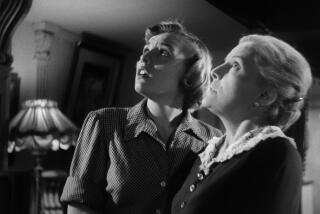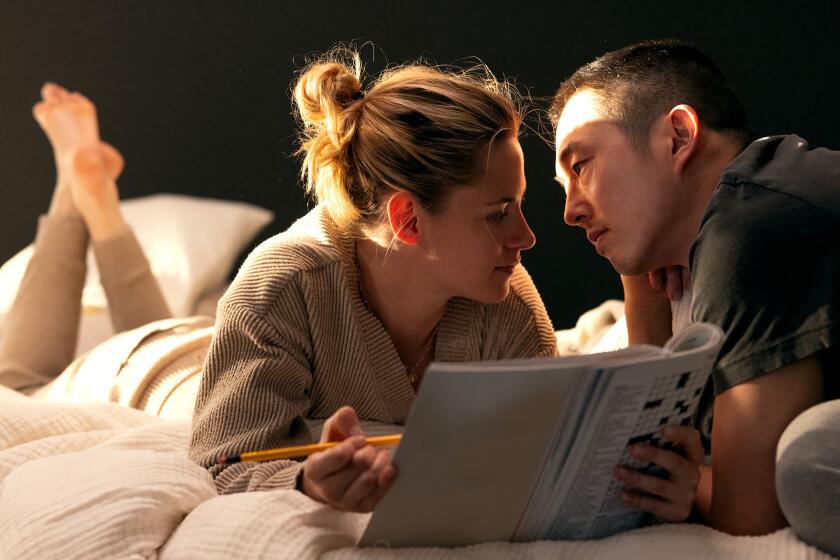The Yakuza’s All Here
- Share via
The American Cinematheque’s outstanding “Battles Without Honor & Humanity: The Films of Kinji Fukasaku” continues Friday at 7 p.m. at the Egyptian with one of the director’s most nihilistic gangster movies, the 1976 “Yakuza Burial.”
Tetsuya Watari, seen last week as a ferocious sociopath in “Graveyard of Honor and Humanity” (1975), is equally intense as a tough cop who winds up siding with a small yakuza outfit when he realizes that their much bigger rival gang is in cahoots with the cops. Amid fiercely violent clashes Watari’s inspector, a man of principle and determination, finds himself increasingly isolated yet also drawn to the wife (Keiko Matsunaga) of a gangster serving a long prison term. Born of a Korean father and a Japanese mother, she shares his sense of isolation and despair.
“Yakuza Burial” is relentlessly uncompromising, as is the 1969 “Japan’s Violent Gangs--Boss” (Saturday at 8:15 p.m.), also known under the less awkward and more appropriate title “Sympathy for the Underdog.” It also concerns a small group of yakuza in defiance of a much larger underworld gang, the Danno, which has spread its tentacles from Osaka to all of Western Japan. The Danno technique is to lure smaller fry into an alliance only to use them to fight their turf wars. Looking every inch the distinguished, if world-weary, middle-aged businessman, Koji Tsurata’s Tsukamoto emerges from eight years in prison to find his own gang in the process of being gobbled up by the Danno group. Radically different in temperament, style and demeanor from Watari’s rebellious cop, Tsukamoto is however also a man of principle, a reflective type who becomes increasingly resigned to his fate, accepting at last that “Once a yakuza, always a yakuza.” Featured are such tough-guy stalwarts as Bunta Sugawara and Tomisaburo Wakayama. Sanae Nakahara is a young nightclub singer drawn to Tsukamoto.
Also notable among this week’s offerings of Fukasaku films is the ferocious, dynamic 1964 yakuza thriller “Wolves, Pigs and People” (Friday at 9:15 p.m.) in which Rentaro Mikuni, then as now one of the Japanese cinema’s most distinguished actors, plays a sleek gangster who has risen from a shantytown to the big time. Unfortunately for him, he has two younger brothers (yakuza icon Ken Takakura and Kinya Kitaoji) who decide to rip him off--only Kitaoji decides to rip both his brothers off. 6712 Hollywood Blvd. (323) 466-FILM.
*
To accompany its “Made in California” exhibition, LACMA is launching its “California Cultures” series, which commences Friday at 7:30 p.m. with Morgan Neville and Harry Pallenberg’s irreverent, insightful “Shotgun Freeway” (1995), surely one of the most ambitious documentaries on Los Angeles, although it has two key drawbacks. First, the role of Asians in local history is slighted, in particular Japanese Americans and their unique World War II internment experience. Second, the film is a 16-millimeter blowup from video, which means most of its splendid, well-chosen archival footage is impossibly murky when projected onto a theater screen.
Offsetting these two not inconsiderable detractions are the filmmakers’ shrewd choices of guides to Greater L.A. Historian Mike Davis, photographed alongside the concrete channel that is the Los Angeles River, takes us back to the city’s pueblo beginnings, and longtime Latino activist Bert Corona (who died last week at age 82) calls attention to the discrimination his people have faced for more than a century. Among the best of the documentary’s witnesses is crime fiction writer James Ellroy, who, when not showing off, observes that some people come to Los Angeles who “want to live some utopian fantasy” and are “driven crazy when they fail.” A droll Buck Henry, who grew up in the motion-picture industry, offers astute takes on Hollywood, and veteran journalist Nick Beck, who grew up in Hollywood, laments its decline. Realtor Elaine Young conducts a breezy, lighthearted tour of Beverly Hills, and architectural historian Margaret Crawford takes us on a revealing ride from one end of Sepulveda Boulevard to the other.
Frank Wilkinson, who was with the postwar public housing authority, relates the repeated betrayal of several housing projects, like the proposed conversion of Chavez Ravine into a Richard Neutra-designed low-cost residential community, as well as his own blacklisting in the McCarthy era. The LAPD’s late, legendary homicide detective John St. John (“Jigsaw John”) recalls key cases in his 51-year career, including the lurid, brutal, never-solved 1947 “Black Dahlia” murder case. Jazz legend Buddy Collette recalls Central Avenue in its nightclub glory days, growing up in Watts and being shooed away by Simon Rodia as he was building his famous towers--and, of course, the hard realities of segregation.
Writer-director John Milius relates the pleasures of surfing; writer Joan Didion comments on the transitory quality of L.A. life, its lack of a sense of history or permanence; and painter David Hockney, a longtime resident, expresses his affection for the city from the splendor of his residence off Mulholland Drive. There’s no way that Neville and Pallenberg could be expected to be all-inclusive, but in their distinctive, personal manner, they and their interviewees do capture an idea of what life is like in Los Angeles and how it got that way. “Shotgun Freeway” will be followed by Jacques Demy’s 1969 valentine to L.A., “The Model Shop,” which finds his “Lola” (Anouk Aimee) adrift in Hollywood.
The Saturday screening of “The Day of the Locust” will be preceded at 7:30 p.m. by a discussion with its cinematographer, Conrad Hall, hosted by writer-director Robert Towne. On Tuesday, LACMA will screen “Alice Doesn’t Live Here Anymore” (1974) as part of an in-person tribute to Ellen Burstyn, who will discuss her career with New York Times film critic Elvis Mitchell. 5905 Wilshire Blvd. (323) 857-6010.
*
A favorite of Marcello Mastroianni among his films was Valerio Zurlini’s “Family Diary” (1962), in which he played a journalist trying to cope with the loss of a younger brother (Jacques Perrin). This beautiful, melancholy film launches the UCLA Film Archive’s eight-film retrospective “Zurlini’s Diaries” Tuesday at 7:30 p.m. in Melnitz Hall’s James Bridges Theater. (310) 206-FILM.
*
The Silent Movie’s Tribute to F.W. Murnau concludes Friday with an 8 p.m. screening of the classic “The Last Laugh” (1924), in which a proud Berlin hotel doorman (Emil Jannings) is devastated by his demotion to men’s room attendant. 611 N. Fairfax Ave. (323) 655-2520.
*
The Nuart will screen a new 35-millimeter print, with new English subtitles, of Fellini’s “Satyricon” (1969) Friday through Tuesday. Gordon Mitchell, star of numerous Italian-made heroic epics and who played a cutthroat bandit in “Satyricon,” will be interviewed Friday at 8:30 p.m. by MGM’s John Kirk, who oversaw the film’s restoration. 11272 Santa Monica Blvd. (310) 478-6379.
More to Read
Only good movies
Get the Indie Focus newsletter, Mark Olsen's weekly guide to the world of cinema.
You may occasionally receive promotional content from the Los Angeles Times.







